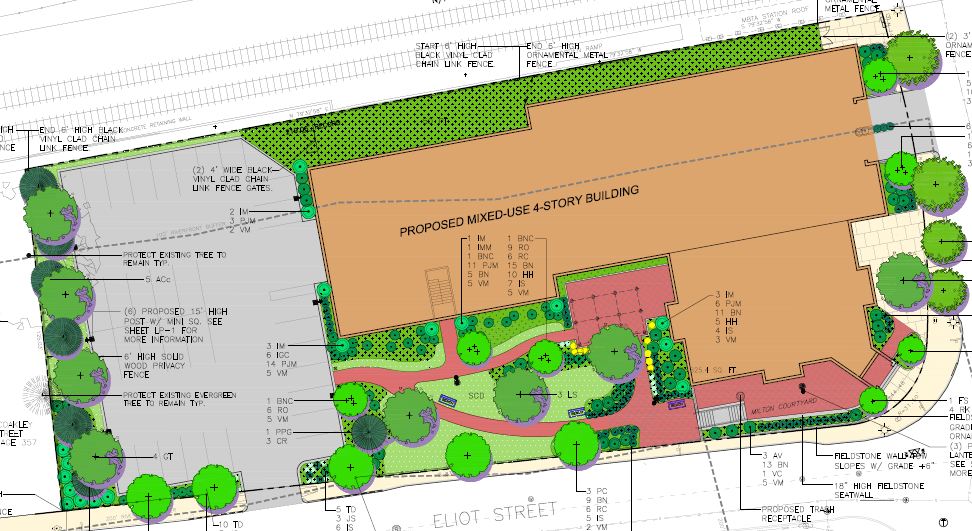Despite urging by the public present at the meeting and the expectation of the developer’s attorney, the Planning Board resisted taking a vote on the granting of a bonus to Connelly Construction, developer of the Hendries site at 131 Eliot Street. The attorney, William McDermott, was hopeful the bonus would be granted; the residents in attendance recommended it be denied. Neither got their wish.
The meeting began with a presentation from Bill Fleming a landscape architect working for Mr. Connelly. He reviewed how the open spaces associated with the current proposal would be treated. There is a small plaza facing Central Avenue and a larger open area that runs along Eliot Street. Following is an illustration of the plan presented. (Please click on image for full PDF view with labels, measurements, etc.)
Mr. Fleming said the goal of the design was to engage the public with the building and an opportunity to enjoy the space.
The architect of the building was not present but had submitted a letter outlining revisions to the overall plan which Chairman Whiteside read into the record. in his letter Mr. Daniel noted that the 4th story along Central Ave had been stepped back by 16′, the public amenities of the brick courtyard on Eliot and the space along Central that will include shade tree and seating, among other changes. He requested that a 10% bonus be granted (a FAR of 1.65). You can find the full text of Mr. Daniel’s letter here.
The residents who spoke did not agree with the characterization of the design. Peter Mullin, a Town Meeting Member from Precinct 2 and member of the board of the Columbine Cliffs Association gave a strong and direct statement to the board. He stated the board should take a vote on the bonus and deny it because the building is “too big, too dense, and does not have public amenities.” He quoted from the bylaw focusing on the criteria that needed to be met to qualify for the bonus. This included “public amenities – plural.” “There is no public amenity there,” said Mr. Mullin referring to the illustration above. The zoning also calls for preserving natural features or replacing in kind. The key feature had been a historic black oak tree which the developer had taken down due to safety concerns. Mr. Mullin asked, “Where is the replacement in kind on that plan? Do you see any replacement on the oak tree? I don’t see it.” Mullin described the open space plan as looking like a “private compound and that is not what it is supposed to be.” Mullin closed by saying that the action that would generate a change would be for the board “to vote no and tell him.”
Several other residents also spoke in support of Mullin’s view. These included but were not limited to fellow CCNA member Ellen DeNooyer and business owner Keith Mills, both of whom have been vocal in advocating for changes to the current design. State Senator Joyce also spoke. He discussed the possibility of a MassWorks grant for funding of construction that contributes to the public benefit and could potentially defray costs to the developer. Joyce first made the suggestion at the last Board of Selectmen’s meeting (View post here.)
Chair Whiteside said, “this plan is not satisfactory to me. . . I was hopeful of seeing that courtyard the major green space to be a major public area and it is not. . . this plan wouldn’t support the award of a bonus. . . but I could see awarding a bonus. . . ” Further, Mr. Whiteside indicated that simply reducing the building by 10% would not solve the issues identified. “We would still have many of the same critiques.” He seeks to keep the issue alive because “I see no reason to deny the bonus because I think it can be incorporated into a reasonable development. . . I think we can work with this design.” Member Duffy said he could go along with that, did not want to vote on award of bonus at that time but that he also wanted to hear back from Mr. Mullin. Mullin felt the grant was a “red herring” and if you want developer to modify his plan you have to say you are not going to grant the bonus [and] that the only way to say that is in a vote.” Whiteside did not agree at which point Member Innes made her position clear:
I’ll make this really easy. . . if the developer does not provide a significant public amenity which we have just defined as shifting the sticky outy bit down in order to preserve roughly the area of the current terrace and properly landscape it. . . I am not voting for a FAR.
